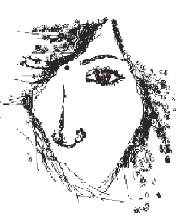 Badami was the headquarters of the Early Chalukyas, who ruled much of Karnataka in the 6th - 8th centuries. The Pallavas captured Badami in 654, but were expelled by Vikramaditya I (655-680). The Early Chalukyas are often called the Early Western Chalukyas to distinguish them from the Early Eastern Chalukyas, a collateral branch in the Eastern Deccan established by Vishnuvardhana in 624.
Badami was the headquarters of the Early Chalukyas, who ruled much of Karnataka in the 6th - 8th centuries. The Pallavas captured Badami in 654, but were expelled by Vikramaditya I (655-680). The Early Chalukyas are often called the Early Western Chalukyas to distinguish them from the Early Eastern Chalukyas, a collateral branch in the Eastern Deccan established by Vishnuvardhana in 624.Early Chalukya sculpture tends to be "classical" (a term now out of fashion, however) in its realism, fullness of modeling, and chasteness of ornamentation; in these respects it has more in common with its predecessors (the Guptas) than with its contemporaries (the Pallavas) and successors. Architecturally, both northern and southern features can be seen, sometimes on the same temple. Huntington, p.337, identifies a set of common features which include: mortarless assembly; temple dimensions that are relatively low, long, and narrow; the use of flat roofs over many-columned halls; richly-carved ceiling panels; and sculptural combinations that consist of just a few major images rather than many smaller ones.
After defeat and absorption by the Rashtrakutas in the middle of the 8th century, Badami remained under Rashtrakutan rule until 973, when it passed under the rule of the Late Chalukyas of Kalyani, a dynasty which claimed descent from the Early Chalukyas of Badami. Late Chalukyan rule lasted until 1189, at which time Badami passed into the control of the Hoysalas.



No comments:
Post a Comment